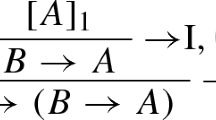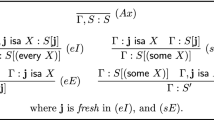Abstract
This paper discusses proof-theoretic semantics, the project of specifying the meanings of the logical constants in terms of rules of inference governing them. I concentrate on Michael Dummett’s and Dag Prawitz’ philosophical motivations and give precise characterisations of the crucial notions of harmony and stability, placed in the context of proving normalisation results in systems of natural deduction. I point out a problem for defining the meaning of negation in this framework and prospects for an account of the meanings of modal operators in terms of rules of inference.
Similar content being viewed by others
Notes
This is an interesting omission: in the systems of Gentzen [16], structural rules are as natural a part of natural deduction as inference rules.
It is sometimes said that there are inconsistent, i.e. non-conservative, connectives that have stable rules. This is impossible on the account of next section: in a logic with only stable rules, neither ⊥ nor an arbitrary atomic proposition is provable. A version of Dummett’s conjecture also holds, but it has to be said that it is not the most interesting result.
There are similarities to the view that logic is ‘topic neutral’ or ‘carries no information’.
In an intuitionist modal logic where both □ and ♢ are present, the restrictions may have to be more complicated. For the classical case, we can assume that the logic only has □.
Or □A, in modal logic. A local peak with □E after ⊥ E can be levelled.
This argument can be found in Hand [18], but it has probably occurred to many philosophers independently, amongst them the present author.
See Price [29–31]. Rumfitt [37] develops a formal framework for the account, which has sparked some discussion. See [11, 12, 17, 38, 39]. Textor [43] is a critical assessment of whether there is a speech act of denial that is prior to the assertion of negated sentences. It is worth adding that according to Tennant and Rumfitt, ⊥ isn’t a proposition, but a ‘structural punctuation mark’. Nonetheless, it plays a role in their calculi that can be played by a proposition or speech act. Despite their declarations, someone who is being taught the rules of their calculi may not come to the conclusion that ⊥ is quite so special, and I’m not convinced that would just be a confusion.
References
Belnap, N. (1962). Tonk, plonk and blink. Analysis, 22, 130–134.
Biermann, G. M., & de Paiva, V. CV. (2000). On an intuitionistic modal logic. Studia Logica, 65, 383–416.
Brandom, R. (2006). The John Locke lectures. http://www.pitt.edu/brandom/locke/index.html Accessed 08 Nov 2013.
Demos, R. (1917). A discussion of a certain type of negative propositions. Mind, 26, 188–196.
Dummett, M. (1978a). The justification of deduction. In Truth and other enigmas (pp. 290–318). London: Duckworth.
Dummett, M. (1978b). The philosophical basis of intuitionistic logic. In Truth and other enigmas (pp. 215–247). London: Duckworth.
Dummett, M. (1981). Frege. Philosophy of language, 2nd edn. London: Duckworth.
Dummett, M. (1993a). The logical basis of metaphysics. Cambridge: Harvard University Press.
Dummett, M. (1993b). What is a theory of meaning? (I). In The seas of language (pp. 1–33). Oxford: Clarendon.
Dummett, M. (1993c). What is a theory of meaning? (II). In The seas of language (pp. 34–93). Oxford: Clarendon.
Dummett, M. (2002). “Yes”, “No” and “Can’t Say”. Mind 111, 289–295.
Ferreira, F. (2008). The co-ordination principles: a problem for bilateralism. Mind, 117, 1051–1057.
Francez, N., & Dyckhoff, R. (2012). A note on harmony. Journal of Philosophical Logic, 41, 613–628.
Frege, G. (1990). Die Grundlagen der Arithmetik. Hildesheim, Zürich, New York: Olms.
Gentzen, G. (1934). Untersuchungen über das logische Schließen. Mathematische Zeitschrift, 39(176–210), 405–431.
Gentzen, G. (1935). Die Widerspruchsfreiheit der reinen Zahlentheorie. Mathematische Annalen, 112, 493–565.
Gibbard, P. (2002). Price and Rumfitt on rejective negation and classical logic. Mind, 111, 297–303.
Hand, M. (1999). Anti-realism and falsity. In D. Gabbay & H. Wansing (Eds.), What is negation? (pp. 185–198). Dortrecht: Kluwer.
Milne, P. (1994). Classical harmony: rules of inference and the meanings of the logical constants. Synthese, 100, 49–94.
Pfenning, F., & Davies, R. (2001). A judgemental reconstruction of modal logic. Mathematical Structures in Computer Science, 11, 511–540.
Prawitz, D. (1965). Natural deduction. Stockholm: Almqvist and Wiksell.
Prawitz, D. (1974). On the idea of a general proof-theory. Synthese, 27, 63–77.
Prawitz, D. (1979). Proofs and the meaning and completeness of the logical constants. In J.H. et al. (Ed.), Essays on mathematical and philosophical logic (pp. 25–40). Dordrecht: Reidel.
Prawitz, D. (1987). Dummett on a theory of meaning and its impact on logic. In B. Taylor (Ed.), Michael Dummett: contributions to philosophy (pp. 117–165). Dordrecht: Nijhoff.
Prawitz, D. (1994a). Meaning theory and anti-realism. In B. McGuiness (Ed.), The philosophy of Michael Dummett (pp. 79–89). Dordrecht: Kluwer.
Prawitz, D. (1994b). Review of the logical basis of metaphysics. Mind, 103, 373–376.
Prawitz, D. (2006). Meaning approached via proofs. Synthese, 148, 507–524.
Prawitz, D. (2007). Pragmatist and verificationist theories of meaning. In R. Auxier & L. Hahn (Eds.), The philosophy of Michael Dummett (pp. 455–481). Chicago: Open Court.
Price, H. (1983). Sense, assertion, Dummett and denial. Mind, 92, 161–173.
Price, H. (1990). Why ‘not’? Mind, 99, 221–238.
Price, H. (2010). ‘Not’ again. http://prce.hu/w/preprints/NotAgain.pdf. Accessed 08 Nov 2013.
Prior, A. (1961). The runabout inference ticket. Analysis, 21, 38–39.
Prior, A. (1964). Conjunction and contonktion revisited. Analysis, 24, 191–195.
Read, S. (2000). Harmony and autonomy in classical logic. Journal of Philosophical Logic, 29, 123–154.
Read, S. (2008). Harmony and modality. In L.K.C. Dégremont & H. Rückert (Eds.), Dialogues, logics and other strange things: essays in Honour of Shahid Rahman (pp. 285–303). London: College Publications.
Read, S. (2010). General-elimination harmony and the meaning of the logical constants. Journal of Philosophical Logic, 39, 557–576.
Rumfitt, I. (2000). “Yes” and “No”. Mind, 109, 781–823.
Rumfitt, I. (2002). Unilateralism disarmed: a reply to Dummett and Gibbard. Mind, 111, 305–312.
Rumfitt, I. (2008). Co-ordination principles: a reply. Mind, 117, 1059–1063.
Russell, B. (1919). On propositions: what they are and how they mean. In Proceedings of the Aristotelian society (Vol. 2, pp. 1–43).
Russell, B. (1956). The philosophy of logical atomism. In Logic and knowledge, essays 1901–1950 (pp. 175–283). Routledge.
Tennant, N. (1999). Negation, absurdity and contrariety. In D. Gabbay & H. Wansing (Eds.), What is negation? (pp. 199–222). Dortrecht: Kluwer.
Textor, M. (2011). Is ‘no’ a force indicator? No!. Analysis, 71(3), 448–456.
Acknowledgments
I would like to thank Anneli Jefferson, Jessica Leech and Julien Murzi for their very helpful comments on this paper.
Author information
Authors and Affiliations
Corresponding author
Rights and permissions
About this article
Cite this article
Kürbis, N. Proof-Theoretic Semantics, a Problem with Negation and Prospects for Modality. J Philos Logic 44, 713–727 (2015). https://doi.org/10.1007/s10992-013-9310-6
Received:
Accepted:
Published:
Issue Date:
DOI: https://doi.org/10.1007/s10992-013-9310-6




